
MAX® NANO
Operation Manual
JPENG FRDE CHN


JP
CHN
ENG
DE
FR
1-23
24-47
48-69
70-93
94-115

Register your new system and enjoy a free,
extended 1-year warranty on the aquarium
glass, in addition to the standard 2-year
system warranty*:

1
ENG
Red Sea MAX®NANO
Installation and Operation Manual
Complete Plug & Play® Open Top Reef System

Red Sea MAX® NANO
2
MAX® NANO Installation & Operation Manual
Safety ........................................................................................4
Location .....................................................................................5
Unpacking the MAX® NANO ............................................. ..........6
Components ..............................................................................7
Assembly ...................................................................................8
Installation of Rear Sump Components .............................................9
Installation of Automatic Top-Off ...........................................13
Installation of LED Modules ..............................................................14
Operation of Pump Switch-box ....................................... ........15
LED Set up and programming .................................................16
Initial Fill ..................................................................................17
Operation of the Protein Skimmer .........................................17
General Aquarium Maintenance .............................................18
Trouble shooting .....................................................................20
Warranty .......................................................................... ........22
To benefit from product update information and special offers exclusive to
registered MAX® owners, please register your MAX® on-line at redseafish.com
Congratulations on your purchase of the Red
Sea MAX® NANO complete reef system.
The Red Sea MAX® approach to the coral reef experience is to create an
environment that is specifically attuned to the needs of coral and all
inhabitants on an artificial reef. In the ocean coral reefs flourish only where
specific physical conditions prevail, such as sufficient light, adequate current,
stable temperature and water quality.
The Red Sea MAX® system provides the conditions that enable you to keep a
thriving, healthy reef in your own home.
We hope that you enjoy your MAX® and wish you happy reefing.

3
ENG
MAX NANO Components
ReefLED 50
Mounting Arm
R40600
ReefLED 50
Sump Screen
R40596
Bubble trap sponge
R40583
Circulation
Pump
R40589
Automatic Top Up
R40594
MAX NANO
Skimmer cup
R40593
MAX NANO
Skimmer Pump
R40591
MAX NANO
Skimmer
body
R40592
Float Valve
R40599
Impellor RS
Flow 950
R50423 (50hz)
R50424 (60hz)
Impellor NANO
Skimmer
R50425 (50hz)
R50426 (60hz)
MAX
NANO
Skimmer
O-Ring
Set
R40579
Pump
outlet
nozzle
R40590
Glass Aquarium
R40597 (Cube)
R40601 (Peninsula)
Surface
skimmer
R40595
Skimmer
Outlet Sponge
R40582
Pump
switch box
R40588
Micron Filter Bag
R40580 (225 micron)
R40581 (100 micron)
EVA mat
R40598 (Cube)
R40604 (Peninsula)

Red Sea MAX® NANO
4
1 Safety
Please read and follow all safety instructions.
a. Do not operate any appliance if it has a damaged cord or plug, if it is
malfunctioning, or if it is dropped or damaged in any manner.
If the external cable is damaged, it shall only be replaced by the
manufacturer.
b. To avoid the possibility of the appliance plug or receptacle getting
wet, position the aquarium stand and tank to one side of a wall
mounted receptacle to prevent water from dripping onto the
receptacle or plug. You should create a "drip loop" (Figure 1) for each
cord connecting an aquarium appliance to a receptacle. The "drip
loop" is that part of the cord below the level of the receptacle, or
the connector. Use an extension cord, if necessary, to prevent water
traveling along the cord and coming into contact with the receptacle.
If the plug or receptacle does get wet, DO NOT unplug the cord.
Disconnect the fuse or circuit breaker that supplies power to the
appliance. Then unplug the device and examine for presence of water
in the receptacle.
c. To avoid injury, do not contact moving parts.
d. Always unplug an appliance from an outlet when not in use, before
putting on or taking off parts, and before cleaning. Never pull the cord
itself to remove the plug from the outlet. Grasp the plug and pull to
disconnect.
e. Do not use an appliance for anything other than its intended use.
The use of attachments not recommended or sold by the appliance
manufacturer may cause an unsafe condition.
f. Do not install or store the appliance where it will be exposed to the
weather or to temperatures below freezing point.
g. Make sure an appliance mounted on a tank is securely installed before
operating it.
Read and observe all the important notices on the appliance.
NOTE: A cord rated for less amperes or watts than the appliance rating
may overheat. Care should be taken to arrange the cord so that
it cannot be tripped over or pulled accidentally.
DANGER: To avoid possible electric shock, special care should be
taken when handling a wet aquarium. For each of the
following situations, do not attempt repairs yourself; return
the appliance to an authorized service facility for service or
discard the appliance.
WARNING: To guard against injury, basic safety precautions should be
observed, including the following:
Drip Loop
Figure 1

5
ENG
2 Location
The first step in setting up the MAX® NANO is to choose
a suitable location.
Electric Supply
Ensure that the electric power supply outlet used for the MAX® NANO
is correctly rated for the system (75W), plus whatever additional
equipment (such as a heater) you plan on adding. The power supply
outlet must be grounded and connected to a circuit protected by a
RCD/RCCB (residual current device or residual current circuit breaker)
also known as a GFI/GFCI (ground fault circuit interrupter).
Floor
The floor directly below the legs must be level and rated for a static
loading of at least 14kg/cm2 (200 lbs/square inch).
Room temperature
Site selection is important for correct temperature maintenance.
We recommend that you keep the ambient room temperature a
comfortable and stable 22°C / 72°F. Avoid placing the tank in front of
an air conditioner, heating vents or direct sunlight. A well ventilated
room with moderate light is the best place to position the aquarium.
Accessibility
• Back: Ensure that there is at least 10cm (4") of clearance behind the
MAX® to allow for sufficient air circulation for a chiller and general ease
of operation.
• Sides (Rear): Ensure that there is sufficient room (approximately
60cm/24”) between both sides of the aquarium and any adjacent walls
or furniture for access to the rear of the tank. This is required for the
regular maintenance of the surface skimmer, protein skimmer, flow
pump and filter media as well as installing/removing cables to the
Pump Switch-box.
General considerations
Ensure that the area surrounding the aquarium is waterproof and
consider moving away anything that water might damage or which may
be corroded by salt.

Red Sea MAX® NANO
6
3 Unpacking the MAX®NANO System
Please read this section carefully before proceeding.
1. Remove the EVA mat and the protective packaging from around the
top of the tank.
2. Remove the components and any packaging materials that are packed
inside the aquarium.
3. Open the accessory box and remove all of the parts for later
assembly.
Removing the aquarium
With one person positioned at either side of the box, grasp the upper
rim of the aquarium and gently lift it out and place on the designated
surface.
CAUTION: The aquarium has a bare glass bottom. Before removing the
aquarium from the box prepare a smooth, soft, clean flat
surface that can hold its weight and place the EVA mat on it.
NOTE: Every precaution has been taken to ensure the safe arrival of the
MAX® NANO aquarium system, however before installing a new
glass aquarium it is advisable to inspect it for damage or leaks.
Place the aquarium in a suitable location and fill the tank and rear
sump to approximately 2.5cm (1”) below the top of the glass.
Leave the water standing for 15 minutes and inspect for leaks.
Syphon all of the water out before moving.
Approximate weights of Aquarium (empty)
Model Metric (kg) Imperial (lb)
MAX NANO Cube 23 51
MAX NANO Peninsula 27 60

7
ENG
4 Components
MAX® NANO system main components MAX® NANO Cube MAX® NANO Peninsula
MAX® NANO type glass aquarium with integral rear sump 75L (20 gal) 100L (26 gal)
MAX® NANO Cabinet (optional) Self-assembly
Pump Switch-box
ReefLED® 50 50W
Rear Sump Protein Skimmer NANO
Circulation pumps 1 x 950lph (240 gph)
Filter sponges 2
Carbon media with drawstring bag 100g
Rear Sump Screen
Automatic Top-Off

Red Sea MAX® NANO
8
5 Assembly
Perform the assembly and installation of all of the components in the
order described below before adding the water to the system.
5.1 Cabinet assembly
Detailed instructions for the assembly of the MAX® NANO cabinet can be
found in the accompanying graphic manual.
The assembly of the cabinet requires the use of a regular crosshead
screwdriver. Do not use an electric screwdriver.
Adjustment of the Push-To-Open (PTO)
door opening unit.
Pressing the end of the PTO unit by 1.5mm
(
1/16”) will spring the shaft
forward by 5cm (2”) to the open position.
Pushing the PTO shaft back inside the cabinet will lock it in the closed
position.
After assembling the cabinet door, make sure that the PTO is in the closed
position and allow the soft close hinges to fully close the door. With the
door in the closed position press the door in the region of the PTO. The door
should spring open. If the door does not spring open adjust the position
of the PTO by rotating the front end of the shaft anticlockwise half a turn.
Repeat this adjustment until pressing the door causes the PTO to operate.
After assembly, place the cabinet in the desired location.
5.2 Pump Switch-box
Align the Pump Switch-box with the holes provided in the rear wall of the
aquarium and fix into position with the screws provided. Do not attach
the LED mounting arm or module at this time.
5.3 Placing Aquarium
Lifting the glass aquarium onto the cabinet will require 2 people. The top
of the cabinet is approximately 86cm (34”) from the floor. Ensure that
anyone lifting the aquarium is physically suitable for such an operation
and has been instructed in the correct methods of lifting heavy objects.
Aquarium must be lifted from the bottom.
Place the EVA mat on the top of the cabinet or other surface that will be
supporting the aquarium. The EVA mat is smaller than the aquarium. Place
the glass flush with the back of the mat and 3mm (1/8") from each of the
sides.
Before lifting aquarium, place the assembled cabinet in the final
operating position (see location above) and set the glass aquarium in
position on top.
The back and sides of the glass should be flush with the rear and side
edges of the top of the cabinet.
Once the aquarium is correctly aligned with the cabinet, check that the
cabinet has not moved. If necessary readjust the position of the cabinet.
NOTE: Left and Right designations in this manual are when looking
from the front of the Aquarium. NOTE: Do not plug the Switch-box power cable to your power outlet
until instructed to do so.
WARNING: If you are not experienced in the construction of self
assembly furniture, seek suitably qualified assistance.

9
ENG
6 Installation of Rear Sump Components
1. Detachable Surface Skimmer
2. Protein Skimmer
3. Carbon
4. Circulation Pump
5. Pump Outlet Nozzle
6. Bubble trap sponge
7. Skimmer Outlet Sponge
8. Automatic Top Up
9. Micron Filter Bag
MAX® NANO rear sump component assembly diagram
9
7
2
5
6
3
1
8
4

Red Sea MAX® NANO
10
Overview of the MAX® NANO filtration and
circulation system
The MAX® NANO rear sump has a complete multistage filtration system
consisting of a REEF-SPEC® protein skimmer, activated carbon and
mechanical filtration materials.
Water circulation in the aquarium and sump is approximately 12
times the entire water volume per hour with forced flow through the
mechanical and chemical filter media while the protein skimmer treats
the water at the SPS spec of approximately 3 times per hour.
The water flows from the aquarium to the rear sump via a detachable
surface skimmer that directs the organics laden water from the upper
surface of the main tank into the rear sump.
From the surface skimmer the water is immediately channeled through a
micron filter bag before entering the skimmer chamber. If the filter bag
is not cleaned frequently enough and becomes blocked, the water will
bypass the micron filter without affecting the overall operation of the
rear sump.
After the skimmer chamber the water is positively drawn through
the REEF-SPEC® carbon and the bubble stripping sponge filter by the
circulation pump located at the bottom of the sump, that returns the
filtered water back to the aquarium through a multidirectional outlet
nozzle. When the pumps are running, the water in the aquarium will be
maintained at approximately 2.5cm (1”) below the rim.
To maintain a constant water height in the system the MAX® NANO includes
an automatic Top-Off system with a 1.5 liter freshwater reservoir which
should be enough to compensate for about 2 days of evaporation. The rear
sump will continue to run efficiently even after evaporation of approximately
1 liter (with an insignificant rise in salinity) and therefore the MAX® NANO
should run for at least 3 days without adding water to the system.
6.1 Protein Skimmer:
The MAX® NANO protein skimmer
consists of three parts: skimmer
body, collection cup and skimmer
pump.
Familiarize yourself with the
skimmer pump by disassembling and
reassembling all of the component
parts. Ensure that the impeller
chamber cover is correctly positioned
and properly secured by the bayonet
ring. Before use check that the pump
and power cable are not damaged.
Diagram key :
a. Skim adjuster
b. Venturi inlet
c. Air pipe
d. Small air pipe
Assemble the skimmer as shown in the diagram.
1. Set the skim adjuster to its lowest position.
2. Connect the air pipe from the venturi inlet of the skimmer pump to
the outlet of the silencer.
3. Connect the small air pipe on the inlet of the silencer.
4. An optional air valve is provided for use with the skimmer. Initially do
not attach the air valve; it is only to be used if required as described
in the operation instructions.
NANO skimmer
b
a

11
ENG
5. Hold the pump cable at the
side of the skimmer, as shown
in the diagram and slide the
skimmer into the skimmer
compartment so that the
silencer just touches the glass
partition.
6. Feed the cable over the back
wall and connect to the left
hand cable of the Pump
Switch Box by tightening the
connector nut.
6.2 Surface Skimmer:
The removable surface skimmer is
supplied assembled in the correct
position in the dividing wall between
the tank and the rear sump. To
remove the surface skimmer simply
raise in the upward direction. Note
the surface skimmer incorporates a
channel that directs the water to the micron filter.
6.3 Micron Filter:
Check that the micron filter bag is
installed in the Filter Bag Holder at
the left of the rear sump.
Place the small black sponge onto
the filter bag holder as shown in
the diagram so that the sponge
is also touching the side of the
skimmer.
Surface Skimmer/comb
skimmer cable
filter bag and sponge
NOTE: The MAX® NANO is supplied with a 225 Micron thin mesh filter
bag (#40580). 100 micron fine polishing filter bags (#40581)
are available from Red Sea dealers.
NANO skimmer
c
d

Red Sea MAX® NANO
12
6.4 Carbon:
Wash the carbon filter material under running water several times to
remove residual dust. It is recommended to soak it in water for 24-72 hrs.
before usage otherwise during the first 3 days after set-up the carbon
may float and release micro air bubbles from inside its pores.
Lower the washed carbon into the chamber to the right of the skimmer
so that it rests on the grid located approximately 30cm (12”) below the
top surface of the glass. To enable easy replacement of the carbon, place
the drawstring of the carbon bag over the silencer of the skimmer.
6.5 Circulation Pumps:
Familiarize yourself with the multidirectional outlet as
shown in the drawing.
Familiarize yourself with the circulation pump by
disassembling and reassembling all of the component
parts. Ensure that the impeller chamber cover is
correctly positioned and properly secured by the
bayonet ring and that the flow valve is in the fully
open position. Screw the hose barb provided into the
outlet of the pump.
1. Before use, check that the pump and power cable
are not damaged.
2. Thread the outlet bayonet connector onto
the flexible pipe and assemble the flexible
pipe to the pump so that the outlet elbow is
perpendicular to the pump as shown in the
drawing.
3. Insert the Eyeball Seat into the Outlet Holder that
is fixed into the glass. This part is a tight fit so that
it will not float out during any pump maintenance
but can be removed if necessary for cleaning.
4. Insert the Eyeball outlet followed by the seal into
the Outlet Holder.
5. Lower the pump into the pump chamber until the
Outlet Elbow with the Bayonet connector is opposite
the Outlet Holder.
6. Screw the Bayonet to the Holder until firmly in
position. Check that the Eyeball is free to rotate but
held securely in the desired position. Initially adjust
the nozzle to the downward position to prevent
splashing when the pump is first switched on.
7. Feed the cable over the back wall and connect to
the right hand cable of the Pump Switch Box by
tightening the connector nut.
8. With the circulation pump secured in position, hold the pump cable
against the back wall, close to the Switch Box and push the black filter
sponge into the pump chamber so that the slit in the sponge is in line
with the flexible pipe.

13
ENG
6.6 Sump Screen:
Position the sump screen above the front wall of the rear sump. Align the
hinges above the clips on the top of the side walls and push firmly into
position. Push the rear of the sump screen until it clicks into position.
To rotate, pull the top of the screen forward until the screen lays flat on
the top of the tank.
7 Automatic Top-Off (ATO):
The MAX® NANO ATO unit is supplied fully assembled and should not need
any adjustment before installing on the system however make sure that
the float valve is at the correct angle as shown in the diagram. Hold the
circulation and skimmer pump cables to the side of the Pump Switch
Box and slide the ATO into position on the rear wall of the sump. Make
sure that the cable of the circulation pump is located in the recess at the
bottom of the reservoir.
NOTE: Do not add RO water to the ATO until you have the correct
amount of seawater in the system.

Red Sea MAX® NANO
14
8 Installation of LED Modules
The ReefLED® 50 for the MAX® NANO is attached to the mounting arm
by a swivel joint. The mounting arm is attached to the aquarium by the
hole provided for it in the top of the Pump Switch-box The complete LED
assembly can be rotated from side to side for ease of aquascaping and
maintenance of the rear sump, specifically when removing the skimmer.
1. Using the M3 screws provided,
attach the swivel connector as
shown in the diagram
2. Push the swivel connector on the
ReefLED onto the arm extension.
Insert the connector pins to both
sides and push until firmly in
position. Screw the fixing screw
into the top of the connector until
the ReefLED is secure.
3. Thread the cable through
the hole in the bend of the
mounting arm and push the
cable-hole plug into position.
4. To attach the LED mounting
arm to the switchbox hold it
so that the pin at the bottom
of the arm is over the hole
in the switchbox and the LED
unit is facing sideways as
shown in the diagram. Place
the cable over the back of
the aquarium.
5. Lower the pin into the hole
and when the flat part on
the arm is in resting on the
Pump Switch Box, rotate the
arm to the forward position.
Thread the cable through the
recess provided in the back of
the Pump Switch Box. Un-
tighten the fixing screw on the
top of the swivel connector.
Adjust the position of the
ReefLED until it is parallel with
the top of the aquarium and re-
tighten the fixing screw.
Find a suitable safe place to
locate the power supply, such as
in the cabinet.

15
ENG
Connect the DC connector from the LED unit to the power supply but do
not plug the power supply into the wall outlet until you are ready to set
up the LED unit.
9 Operation of Pump Switch-box
The Pump Switch-box is designed to provide easy on/off control of the
circulation and skimmer pumps during routine activities such as feeding
or maintenance.
Ensure that the 2 switches are in the off position and plug the power
cable to the wall outlet. Do not switch the pumps on until both pumps
are fully submerged in water.
The cable connectors are designed to prevent any ingress of water when
used in the designed manner. The connectors are not waterproof and
must not be immersed in water.

Red Sea MAX® NANO
16
10 LED Set up and programming
To set up and program the ReefLED® 50 follow the instructions provided
with the LED module:
Programming guidelines:
Photoperiod: Day/moonlight
The day photoperiod should be between 8 – 12 hours with no more than
about 9 hours at maximum intensity. Corals and fish must have daily
periods of darkness. Moonlight should be limited to a maximum period of
about 4 hours.
Acclimation
To prevent photo-inhibition due to the high intensity of LED lights, an
acclimation period is recommended for new systems or when introducing
new corals.
Acclimation will vary for different kinds of corals however it is
recommended to allow a period of 8 weeks for new set-ups.
During the acclimation period look for signs of photo stress and photo-
inhibition such as:
• Whitening/Bleaching of the upper section of the tissue (the lower
section will continue to show pigments and zooxanthellae).
• Polyps retraction.
• Gas bubbles inside the soft tissue.
In the event of any of the above symptoms immediately reduce the
Acclimation intensity by 20% for about 4 weeks and thereafter increase
by 5% per week until maximum intensity is reached.
When introducing new corals to already acclimated systems, start by
positioning them at the lower levels of the aquarium and gradually
raising them to their desired position over a period of several weeks.
Keep watching for signs of photo inhibition/stress and if necessary return
an affected coral to lower levels for recuperation.
Seite wird geladen ...
Seite wird geladen ...
Seite wird geladen ...
Seite wird geladen ...
Seite wird geladen ...
Seite wird geladen ...
Seite wird geladen ...
Seite wird geladen ...
Seite wird geladen ...
Seite wird geladen ...
Seite wird geladen ...
Seite wird geladen ...
Seite wird geladen ...
Seite wird geladen ...
Seite wird geladen ...
Seite wird geladen ...
Seite wird geladen ...
Seite wird geladen ...
Seite wird geladen ...
Seite wird geladen ...
Seite wird geladen ...
Seite wird geladen ...
Seite wird geladen ...
Seite wird geladen ...
Seite wird geladen ...
Seite wird geladen ...
Seite wird geladen ...
Seite wird geladen ...
Seite wird geladen ...
Seite wird geladen ...
Seite wird geladen ...
Seite wird geladen ...
Seite wird geladen ...
Seite wird geladen ...
Seite wird geladen ...
Seite wird geladen ...
Seite wird geladen ...
Seite wird geladen ...
Seite wird geladen ...
Seite wird geladen ...
Seite wird geladen ...
Seite wird geladen ...
Seite wird geladen ...
Seite wird geladen ...
Seite wird geladen ...
Seite wird geladen ...
Seite wird geladen ...
Seite wird geladen ...
Seite wird geladen ...
Seite wird geladen ...
Seite wird geladen ...
Seite wird geladen ...
Seite wird geladen ...
Seite wird geladen ...
Seite wird geladen ...
Seite wird geladen ...
Seite wird geladen ...
Seite wird geladen ...
Seite wird geladen ...
Seite wird geladen ...
Seite wird geladen ...
Seite wird geladen ...
Seite wird geladen ...
Seite wird geladen ...
Seite wird geladen ...
Seite wird geladen ...
Seite wird geladen ...
Seite wird geladen ...
Seite wird geladen ...
Seite wird geladen ...
Seite wird geladen ...
Seite wird geladen ...
Seite wird geladen ...
Seite wird geladen ...
Seite wird geladen ...
Seite wird geladen ...
Seite wird geladen ...
Seite wird geladen ...
Seite wird geladen ...
Seite wird geladen ...
Seite wird geladen ...
Seite wird geladen ...
Seite wird geladen ...
Seite wird geladen ...
Seite wird geladen ...
Seite wird geladen ...
Seite wird geladen ...
Seite wird geladen ...
Seite wird geladen ...
Seite wird geladen ...
Seite wird geladen ...
Seite wird geladen ...
Seite wird geladen ...
Seite wird geladen ...
Seite wird geladen ...
Seite wird geladen ...
Seite wird geladen ...
Seite wird geladen ...
Seite wird geladen ...
Seite wird geladen ...
-
 1
1
-
 2
2
-
 3
3
-
 4
4
-
 5
5
-
 6
6
-
 7
7
-
 8
8
-
 9
9
-
 10
10
-
 11
11
-
 12
12
-
 13
13
-
 14
14
-
 15
15
-
 16
16
-
 17
17
-
 18
18
-
 19
19
-
 20
20
-
 21
21
-
 22
22
-
 23
23
-
 24
24
-
 25
25
-
 26
26
-
 27
27
-
 28
28
-
 29
29
-
 30
30
-
 31
31
-
 32
32
-
 33
33
-
 34
34
-
 35
35
-
 36
36
-
 37
37
-
 38
38
-
 39
39
-
 40
40
-
 41
41
-
 42
42
-
 43
43
-
 44
44
-
 45
45
-
 46
46
-
 47
47
-
 48
48
-
 49
49
-
 50
50
-
 51
51
-
 52
52
-
 53
53
-
 54
54
-
 55
55
-
 56
56
-
 57
57
-
 58
58
-
 59
59
-
 60
60
-
 61
61
-
 62
62
-
 63
63
-
 64
64
-
 65
65
-
 66
66
-
 67
67
-
 68
68
-
 69
69
-
 70
70
-
 71
71
-
 72
72
-
 73
73
-
 74
74
-
 75
75
-
 76
76
-
 77
77
-
 78
78
-
 79
79
-
 80
80
-
 81
81
-
 82
82
-
 83
83
-
 84
84
-
 85
85
-
 86
86
-
 87
87
-
 88
88
-
 89
89
-
 90
90
-
 91
91
-
 92
92
-
 93
93
-
 94
94
-
 95
95
-
 96
96
-
 97
97
-
 98
98
-
 99
99
-
 100
100
-
 101
101
-
 102
102
-
 103
103
-
 104
104
-
 105
105
-
 106
106
-
 107
107
-
 108
108
-
 109
109
-
 110
110
-
 111
111
-
 112
112
-
 113
113
-
 114
114
-
 115
115
-
 116
116
-
 117
117
-
 118
118
-
 119
119
-
 120
120
Red Sea MAX NANO Cube Bedienungsanleitung
- Typ
- Bedienungsanleitung
- Dieses Handbuch eignet sich auch für
in anderen Sprachen
Verwandte Artikel
-
Red Sea MAX E-260 Bedienungsanleitung
-
Red Sea REEFER 350 G2 Bedienungsanleitung
-
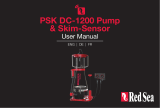 Red Sea REEFER DC Skimmer 300 Bedienungsanleitung
Red Sea REEFER DC Skimmer 300 Bedienungsanleitung
-
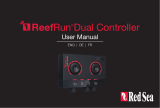 Red Sea ReefRun 9000 Bedienungsanleitung
Red Sea ReefRun 9000 Bedienungsanleitung
-
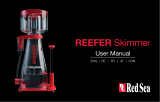 Red Sea REEFER Skimmer 600 Benutzerhandbuch
Red Sea REEFER Skimmer 600 Benutzerhandbuch
-
Red Sea Reef Energy Plus Bedienungsanleitung
-
Red Sea 7029 Benutzerhandbuch
-
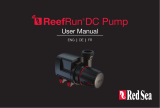 Red Sea ReefRun 9000 Bedienungsanleitung
Red Sea ReefRun 9000 Bedienungsanleitung
-
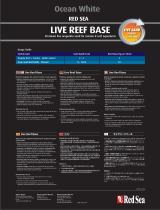 Red Sea Reef Base White Bedienungsanleitung
Red Sea Reef Base White Bedienungsanleitung
-
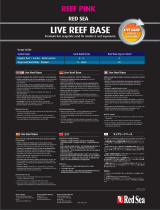 Red Sea Reef Base Pink Bedienungsanleitung
Red Sea Reef Base Pink Bedienungsanleitung
Andere Dokumente
-
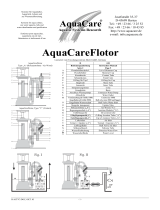 AquaCare Flotor A Benutzerhandbuch
AquaCare Flotor A Benutzerhandbuch
-
Aqua Medic Percula 100 Bedienungsanleitung
-
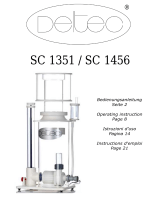 Deltec Protein Skimmer SC SC 1456 Operating
Deltec Protein Skimmer SC SC 1456 Operating
-
EHEIM 0340701 Bedienungsanleitung
-
EHEIM skimmarine 100 Bedienungsanleitung
-
Aqua Medic Turboflotor 750 Bedienungsanleitung
-
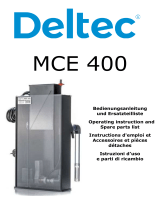 Deltec MCE 400 Bedienungsanleitung
Deltec MCE 400 Bedienungsanleitung
-
EHEIM skim350 Bedienungsanleitung
-
Aqua Medic Reef Station Bedienungsanleitung
-
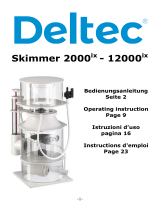 Deltec Skimmer 9000ix Bedienungsanleitung
Deltec Skimmer 9000ix Bedienungsanleitung

































































































































